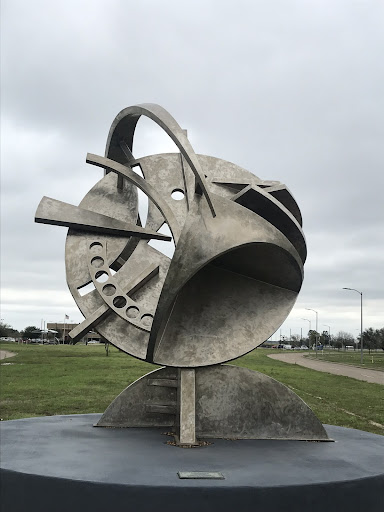
Genesis
Location: Easterwood Airport, 1 McKenzie Terminal Blvd, College Station, TX 77845
Description: Brushed stainless steel geometric sculpture. 2,000 lbs. It was first constructed in Caldwell, Texas, by James Urbanosky, master craftsman. Koustouv is a native of Ivanova, Russia, and a well-known painter. This is his first work of public sculpture. Foundation and platform generously constructed by Dudley Construction. Dedicated October 20, 2003.
Artist: Dmitri Koustov
Medium: Ferrous Metal
Dimensions: 12 x 12 x 12 (H, W, D)
You Be the Judge
There are people who say that art should not be judged good or bad, that art is for art’s sake, and, therefore, rendering a judgment upon a work of art is inappropriate. While such an approach may be noble, it is hardly realistic. We all wish to project our own feelings and thoughts upon almost everything we encounter, especially works of art. It is a way for us to relate and participate in our environment; indeed, it is a way for us to share our world with artists and the world they represent. Some philosophers have argued that judging works of art is inherently subjective (in the eye of the beholder), while others have argued that it must be objective (universally recognized by everyone as the same). In the end, such arguments are useless because the end result is always individual – how one arrives at a given judgment is methodologically interesting but not very conclusive.
So, now that we have the question of whether or not we judge a work of art out of the way let’s see if we can agree upon some basic criteria by which we may indulge our proclivity to judge. A good way to begin is to examine craftsmanship, that is, painting, sculpture, photography, performance, or wordsmithing. If the artist’s craft is good and demonstrates creativity, then proceed to examine the subject matter. Is it truthful? Does it express emotions and feelings? Can you relate? Does it seem to be of our world or an alien world? In short, does it represent, either abstractly or realistically, something that you can share with the artist? Does it have as its purpose communicating an idea and/or marketing an item, or does it symbolize truth and emotion? Finally, if you determine the craftsmanship and the representation are good, ask yourself if the artist is truthful. In other words, do you believe that the subject represents true emotions and feelings? If you examine a work of art and can answer yes to the above questions, you probably have found a good work of art. Enjoy!
Genesis: The Story
The Arts Council of Brazos Valley planned a work of public art for Texas A&M University’s Easterwood Airport during the summer of 1998. A group of students from the Eisenhower Leadership Program worked with David P. Romei, Executive Director of the Arts Council, to develop a five-year plan for public art. One of the many sites chosen was the very site where Genesis is now displayed.
In 1992, Mr. John Happ, Director of the Easterwood Airport, asked the Arts Council to consider a work of sculpture that might symbolically represent the earth. Mr. Happ sees the airport as the Brazos Valley’s gateway to the world, and he hoped that a sculpture could symbolize the significance of air flight and Easterwood’s importance to our community.
Dr. Romei commissioned Mr. Dmitri Koustouv, an artist from Russia who is living in the Brazos Valley with his wife, Larissa, and daughter, Alexandra (Sasha). Larissa is completing her doctorate in education at Texas A&M University. Mr. Koustouv’s professional artists’ vita is in this program.
Genesis is located on a formerly vacant island just behind the College Station Easterwood sign that one encounters as one drives out of the underpass on Robert Stotzer Boulevard toward the airport terminal building. It is an abstract work with some semblance of relative representation, most obvious to those who have been exposed to he dynamic forces of aesthetic creativity.
Genesis is crafted, welded, and constructed entirely from stainless steel. It weighs just over 6,000 pounds and is the largest stainless steel sculpture in the Brazos Valley. Its height is approximately 14 feet, and its width is 10 feet. The base is reinforced concrete/steel poured upon a stabilizing pier. The facade of the foundation base is ceramic tile.
The sculpture is named Genesis because it is symbolic of the earth’s early creation. Its form includes the longitudes and latitudes represented upon an imaginary skeleton of the earth’s interior with a wisp of future surface in the form of a contrail. The artist decided to name the work after the first book of the Holy Bible, the book on which one finds the story of creation. The technical aspects mentioned herein, i.e., contrail, longitude, and latitude, serve to remind us of travel and flight. Moreover, the stainless steel replicates the color of airplane fuselage construction during the early jet age.
It is hoped that the sculpture comes to symbolize the reverence in which our community has invested its faith in the Creator. Genesis represents the imagined chaos of creation. It is symbolic of the creative process required to give birth to the most beautiful planet in the universe. As we value our world and the God that created it, so let us stand in admiration of this work of art, a truthful expression of emotions and feelings by a most gifted artist.
